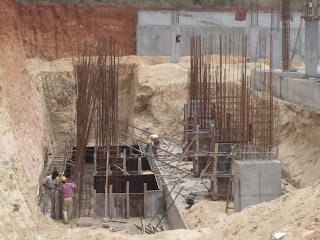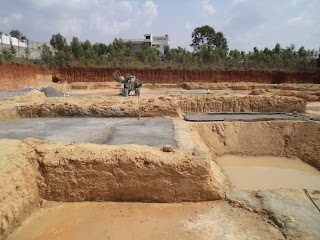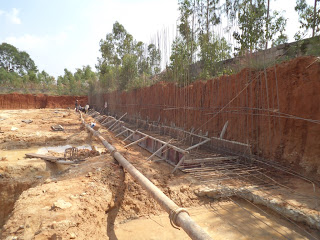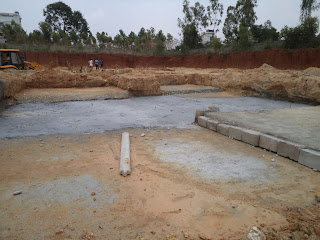Saturday, July 30, 2011
Thursday, July 21, 2011
Sunday, June 12, 2011
Site Work Progress 10.6.11
 |
| Concrete Batching Plant |
 |
| Earth Works in progress |
 |
| Part of T2 works |
 |
| Reinforcement works at site |
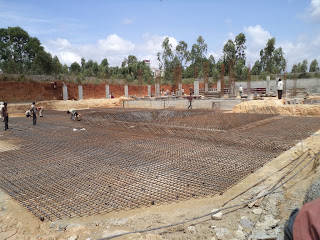 |
| T1 raft reinforcement works in progress |
 |
| T2 lift pit works |
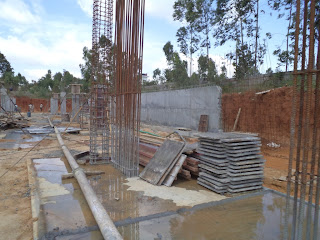 |
| T2 Main raft part and back side retaining wall |
 |
| View from Tower 2 NE corner |
 |
| View from T2 North |
 |
| View of completed portion of T1 raft and a few columns |
 |
| View of site from batching plant - concrete pipe can be seen |
Saturday, June 4, 2011
Reduce ecological impact of corporate meetings and events
14 ways to reduce the ecological impact of corporate events and meetings—some simple and cheap, some not so much.
1. Use LEDs
Lighting is one of the most obvious ways an event consumes energy, and a growing number of technologies offer more earth-friendly solutions. While long-life fluorescent bulbs are replacing traditional incandescent lights in consumers' homes, this isn't a practical solution for most event planners.
LED lights, on the other hand, win raves from lighting and event specialists for their convenience and low energy usage. An LED fixture of comparable brightness uses up to 80 percent less energy than its conventional counterpart. Another perk of LED lights is that the lights themselves come in every color of the rainbow, so there's no need to set up huge (and labor-intensive) rigs with films if you want a multicolored look.
2. Rethink Your Cars
While hybrid cars such as the Toyota Prius are the best-known, there are a variety of alternative-fuel vehicles on the road, and a few forward-thinking car services are offering these vehicles. For large groups, the company can offer hybrid diesel shuttles as an alternative.
3. Table New Cloths
Now let's look at table linens—and the materials they're made of. As with food, you can go the organic route, using organic cotton and linen. While hemp has an earth-friendly image, environmental experts are on the fence as to its actual benefits as an eco-friendly event textile; proponents point out that it's much easier on the earth to grow hemp than to grow cotton or to produce synthetics like polyester. And don't forget to ask about the dye process—conventional dyeing methods use harsh chemicals.
Before placing an order, consider this: If you're not having linens custom-made, you'll probably be reusing existing linens, and reusing is always a green option.
4. Go Organic
It's hard to find a person who isn't acquainted with the idea of chemical- and additive-free food, and a growing number of companies are turning to sustainable and organic catering for internal as well as promotional events.
5. Skip the Styrofoam
Rental firms can rejoice—their business model is already eco-friendly. When it comes to disposables, plastic and plastic-foam dishes are so last century. The cutting edge of disposable tableware is plates, bowls, and even flatware made from plant-based materials: starches from corn, potatoes, or sugarcane, or fast-growing plants like bamboo.
6. Reduce Garbage
Many green events have prominently displayed recycling containers next to regular trashcans, and a few have gone so far as to include composting containers.
7. Avoid Vinyl
Vinyl is the conventional choice for a customized backdrop; what it offers in ubiquity and convenience, however, it lacks in earth-friendliness. Not only is the material made from nonrenewable resources, but there's no way to recycle it effectively.
That said, it's tough to find a replacement without dreaming up an entirely different kind of display, which will be pricier and more complicated.
8. Donate Leftovers
Another way to reduce an event's waste is by donating leftovers. It can be harder to track down groups that want to take your leftovers outside of major cities. You will always be able to find someone—sometimes even a homeless shelter—grateful for the provisions, but sometimes it takes more work. Ask your venue, though; the folks there can often point you in the direction of a recipient.
Cost: Since most food-rescue organizations will provide containers for packaging leftovers and pick up the food, this shouldn't put a ding in your budget at all. The exception would be if you're donating on a one-off basis to a group (such as a shelter) that doesn't have an established program; in that case, you might need to factor in the expense of containers and ferrying the food to its destination.
9. Keep Plants Alive
Depending on whether or not you plan to reuse them for future events, using plants can be a highly cost-effective option—provided the decorations and planters aren't overly extravagant.
10. Nix Single Servings
Water bottles are convenient and ubiquitous, but all those bottles usually wind up in landfills, and the water in half-full bottles is poured down the drain—a tremendous waste, environmental advocates say. Lunches should not be pre-boxed if possible, and side items like chips and cookies should be offered loose, in bowls or platters rather than in individual packages.
11. Offset Emissions
Carbon offsetting has gotten a lot of buzz lately, but environmental experts are divided on its effectiveness. It works like this: Go to the Web site of a carbon-offsetting service such as Driving Green or Carbon Fund and plug in a few vital stats about your event. The service calculates how much carbon dioxide the event will produce and gives you a dollar amount.
12. Tweak the Temp
Controlling the temperature in the room can definitely be earth-friendly—lowering the heat in the winter and keeping the AC down or off in the summer both save energy. The question remains whether it's guest-friendly as well
13. Print Wisely
Event specialists have many options when it comes to making invitations and programs more eco-conscious. When it comes to ink, soy-based inks are preferable to conventional inks, which are made from nonrenewable petroleum. But an even more earth-friendly option is using vegetable-based inks, since soybeans aren't always grown in an eco-friendly manner. Ask upfront if your printer can provide one or the other, since eco-friendly inks aren't yet as commonly available as recycled paper.
14. Cut the Handouts
For some events, the option of replacing paper programs or binders with CDs or flash drives—thumb-sized devices that store data and can be plugged into any computer's USB port—can be a godsend. If attendees typically leave laden with handouts (including many, let's face it, they'll never look at), flash drives are not only thoughtful but stand a better chance of actually being taken home and read. You can also consider having maps and directions available for download onto cell phones, PDAs, or other gadgets, so guests don't have to print them out, if you have an appropriately tech-savvy crowd.
Tuesday, May 31, 2011
Bhuvana Greens - Work in Progress
 |
| Panoramic View 28th May, 2011 |
 |
| Retainer wall in progress |
 |
| Retainer wall in progress 2 |
 |
| Tower 1 Basement columns work in progress |
 |
| Tower 2 Basement work |
 |
| Tower 1 Basement work |
TOWER 1 :
- PODIUM FLOORING AND COLUMNS CONCRETE IN PROGRESS
- MAIN FOOTINGS/ RAFT REINFORCEMENT AND CONCRETE WORKS IN PROGRESS
- RETAINING WALL WORKS IN PROGRESS
TOWER 2 :
- PODIUM FLOORING AND COLUMNS CONCRETE IN PROGRESS
- MAIN FOOTINGS/ RAFT REINFORCEMENT WORKS IN PROGRESS
Tuesday, May 17, 2011
Sunday, May 15, 2011
Waste Segregation
A kabadiwala is welcomed with much fanfare at Indian homes, with people disposing of old newspapers, books, cans etc. This is a form of segregation we have been used to see, since childhood, when on lazy Sunday mornings we would take pride in "cleaning" the trash. This was a religious routine in our homes.
But as time has moved ahead, so has the needs to refine this method. Segregation of waste is the method of separation of waste, so that accordingly the waste which is not bio-degradable can be recycled or re-used. Actually a part of the waste can be converted to compost or manure, the other can be recycled, only a very small part of it has to be discarded.
Household waste should be disposed off separately as wet and dry waste. Toxic wastes like batteries, medicines, bulbs should be disposed separately. Wet waste, which consists of leftover foodstuff, vegetable peels, etc., should be put in a compost pit and the compost could be used as manure in the garden. Dry waste consisting of cans, aluminium foils, plastics, metal, glass, and paper could be recycled. If we do not dispose of the waste in a more systematic manner, more than 1400 sq. km of land, which is the size of the city of Delhi, would be required in the country by the year 2047 to dispose of it.
But as time has moved ahead, so has the needs to refine this method. Segregation of waste is the method of separation of waste, so that accordingly the waste which is not bio-degradable can be recycled or re-used. Actually a part of the waste can be converted to compost or manure, the other can be recycled, only a very small part of it has to be discarded.
Household waste should be disposed off separately as wet and dry waste. Toxic wastes like batteries, medicines, bulbs should be disposed separately. Wet waste, which consists of leftover foodstuff, vegetable peels, etc., should be put in a compost pit and the compost could be used as manure in the garden. Dry waste consisting of cans, aluminium foils, plastics, metal, glass, and paper could be recycled. If we do not dispose of the waste in a more systematic manner, more than 1400 sq. km of land, which is the size of the city of Delhi, would be required in the country by the year 2047 to dispose of it.
Door-to-door collection of waste is another method of segregation, but it is not a common practice as yet in India except in the metros where some private organizations are doing such work. The rag picker plays a very important part in the segregation of waste.
It is now becoming more and more essential to look for methods by which the garbage load on the land can be reduced. It has been seen that at present segregation of waste at source level seems to be the best.
A large number of NGOs (non-governmental organizations) are working in the field of solid waste management such as Clean Ahmedabad Abhiyan in Ahmedabad, Waste-Wise in Bangalore, Mumbai Environmental Action Group in Mumbai, and Vatavaran and Srishti in Delhi. They are all successfully creating awareness among the citizens about their rights and responsibilities towards solid waste and the cleanliness of their city. These organizations promote environmental education and awareness in schools and involve communities in the management of solid waste.
The role of the rag picker
Rag pickers are the people who are actually going through the garbage bins to pick out the ‘rags’. These rag pickers, women, children, and men from the lowest rung in the society, are a common sight in most cities and towns around the country. Rag picking is considered the most menial of all activities and it is people who have no other alternative that are generally driven to it. Rag pickers contribute a great deal to waste management as they scavenge the recyclable matter thereby saving the municipality of the cost and time of collecting and transporting this to the dumps.
The rag picker has a special role to play in the segregation of waste in India. He is one of the focal points for the recycling of waste. He is the person who, in spite of all the dangers that he faces, goes on relentlessly picking through the garbage bin, looking for waste that could be useful to him. He sells all the material he picks to the whole sellers and retailers who in turn sell it to the industry that uses this waste matter as raw material. The main items of collection are plastics, paper, bottles, and cans.
Rag pickers are well coordinated in their method of working. Among themselves, they have a good understanding for operating by area. Each group takes specific items from the bins. It has been observed that more and more women and children are getting involved in the business of rag picking. This is a matter of concern as these children who should be spending their time in schools either studying or playing are instead putting themselves at risk by handling waste. While picking through waste, the rag picker puts himself at a great risk and is always prone to disease as the waste that he rummages through can be infected.
We can indirectly help the rag picker by carefully segregating the waste that is generated at our homes, thereby facilitating his search for materials that are useful to him. He will not have to scavenge in the bins for long hours.
Wednesday, May 11, 2011
Securing Homes
I order to safeguard our houses and our valuables, a proper locking system is a must - have for any home. For several decades, simple locks were used to lock any any building. This was followed by brass padlocks with multiple levers and row pin cylinder type locks combined with electronic locking system. For extra safety, many houses are equipped with iron bars for the front and back doors. A peephole with a lens fixed to the front door and a safety chain are also ways of checking the credentials of the people before letting them in. In addition, steel grill doors are much in vogue today.
As the city has grown, residential localities have extended to areas beyond the heart of the city by many kilometers, with a subsequent increase in the chances of burglary. Security concerns are especially high in places where working couples have to leave their children alone and when elderly people live. Modern technology has come to force to address security problems for such buildings. Electronic security systems installed in houses and apartments raise an alarm against possible intrusion. Taking all these factors into consideration, many builders today are increasingly showing interest in installing the same in multistoreyed apartments and other buildings.
How the system works
There are different kinds of electronic security systems with different functions. A simple alarm system against an attempt to tamper the door to several hi-tech ones available in the market.
A video door phone is a system which helps residents identify a visitor through a monitor installed inside the house and communicates without opening the doors. This also has the facility of operating the door by remote control.
Another is the intrusion alarm system. Here, a control panel is installed inside the house. It is fitted with magnetic connector for the door, motion detector, glass breaking detectors and sensors for the windows and other possible accessible places. Any obstruction noticed by the system raise an alarm. This is a useful precautionary device. Many companies which provide these security systems have a Central Monitoring System. In this warning signals from individual customers are recorded and monitored. In a Central Monitoring System, Infra red signals are turned to sense obstacles which are over three and half feet in height and weighs more than 25 kgs in order to restrict false alarms. Even biometric systems are available which can be seen at Tirumala Temple where flow of people is very high. In this advanced technology scanning of fingers and retina can also be undertaken.
Different types of signals like fire accident, medical emergency and others can be identified and the police, the doctor or fire station, depending on the emergency can be contacted.The system provides early warning against attempt of burglary or any emergency like sudden illness; it helps not only save valuables but also the lives of the inmates of the house. An auto dialing system can also be fixed to these systems where prioritized numbers can alert the police, family members or the doctor. CCTV (Closed Circuit Television ) and an Access Control system which restrict the entry of unauthorized people are also available as a part of electronic security systems. Some of these systems have other unique features like identifying pet animals so that false signals are avoided to a certain extent. Panic buttons to identify leakage of gas alignment, electric shock circuits are other features provided in these systems. All these systems are safe, easy to operate and cannot be easily tampered with is the opinion of many suppliers who are in the market since a long time.
As the city has grown, residential localities have extended to areas beyond the heart of the city by many kilometers, with a subsequent increase in the chances of burglary. Security concerns are especially high in places where working couples have to leave their children alone and when elderly people live. Modern technology has come to force to address security problems for such buildings. Electronic security systems installed in houses and apartments raise an alarm against possible intrusion. Taking all these factors into consideration, many builders today are increasingly showing interest in installing the same in multistoreyed apartments and other buildings.
How the system works
There are different kinds of electronic security systems with different functions. A simple alarm system against an attempt to tamper the door to several hi-tech ones available in the market.
A video door phone is a system which helps residents identify a visitor through a monitor installed inside the house and communicates without opening the doors. This also has the facility of operating the door by remote control.
Another is the intrusion alarm system. Here, a control panel is installed inside the house. It is fitted with magnetic connector for the door, motion detector, glass breaking detectors and sensors for the windows and other possible accessible places. Any obstruction noticed by the system raise an alarm. This is a useful precautionary device. Many companies which provide these security systems have a Central Monitoring System. In this warning signals from individual customers are recorded and monitored. In a Central Monitoring System, Infra red signals are turned to sense obstacles which are over three and half feet in height and weighs more than 25 kgs in order to restrict false alarms. Even biometric systems are available which can be seen at Tirumala Temple where flow of people is very high. In this advanced technology scanning of fingers and retina can also be undertaken.
Different types of signals like fire accident, medical emergency and others can be identified and the police, the doctor or fire station, depending on the emergency can be contacted.The system provides early warning against attempt of burglary or any emergency like sudden illness; it helps not only save valuables but also the lives of the inmates of the house. An auto dialing system can also be fixed to these systems where prioritized numbers can alert the police, family members or the doctor. CCTV (Closed Circuit Television ) and an Access Control system which restrict the entry of unauthorized people are also available as a part of electronic security systems. Some of these systems have other unique features like identifying pet animals so that false signals are avoided to a certain extent. Panic buttons to identify leakage of gas alignment, electric shock circuits are other features provided in these systems. All these systems are safe, easy to operate and cannot be easily tampered with is the opinion of many suppliers who are in the market since a long time.
Tuesday, May 10, 2011
Every Drop Counts
1. Don't let the water run when washing your hands, brushing your teeth or shaving. Depending on your mixer, you lose about 7 to 20 litres of water this way - per minute. Turn off the water in the meantime or use a glass of water for brushing your teeth. For a wet shave, it is sufficient to fill the basin with a small amount of water before starting to shave.
2. For a full bath, you need about 140 litres of water. Showering however, consumes far less water, particularly when using a shower with EcoSmart Technology. An economic shower which uses only say 6 litres per minute, the water consumption is only 18 litre for a 3 minute shower without any sacrifice of comfort.
3. If solar energy is unavailable, heating water is bound to require fossil fuels. Therefore, those who save hot water reduce the production of greenhouse gas. In a household with four people water saving showers reduce the consumption of carbon dioxide by up to 700 kg per year.
4. A large portion of domestic water consumption - about 35 litres per person per day - is the water used for flushing the tiolet. Installing an interrupt control or a dual flush system is particularly worthwhile, since small flushes usually don't require more than 3 litres of water. This can save up to 10,000 litres of drinking water per person per year.
5. Domestic appliances like washing machines and dishwashers also use a considerable amount of water. When buying new appliances, pay attention to their energy efficiency class and chose a model of class of class A, or even better , A+, A++.
6. Of course, you can save most water by using it twice. A domestic grey water recycling system which can be easily integrated in to the planning of new homes or reconstruction projects, purifies, purifies the water used in bath and shower and makes it available as clear water - for example for flushing the toilet or watering the garden. Even collecting rain water by means of a water butt can have significant impact.
7. Even our buying habits have an influence on water consumption. For example, producing 1 kg of paper made from fresh fibers creates 100 litres of waste water, while the production of recycled paper uses only 15 litres of water per kg, saving natural resources at the same time. When buying toilet paper or writing paper, choose products from a well known eco label.
8. Enormous amounts of water are used in food production as well. For example, the artificial irrigation of vegetable fields in dry regions entails huge environmental problems. A diet which is geared towards seasonal and regional availability is not only better for the environment, but also better for your health.
2. For a full bath, you need about 140 litres of water. Showering however, consumes far less water, particularly when using a shower with EcoSmart Technology. An economic shower which uses only say 6 litres per minute, the water consumption is only 18 litre for a 3 minute shower without any sacrifice of comfort.
3. If solar energy is unavailable, heating water is bound to require fossil fuels. Therefore, those who save hot water reduce the production of greenhouse gas. In a household with four people water saving showers reduce the consumption of carbon dioxide by up to 700 kg per year.
4. A large portion of domestic water consumption - about 35 litres per person per day - is the water used for flushing the tiolet. Installing an interrupt control or a dual flush system is particularly worthwhile, since small flushes usually don't require more than 3 litres of water. This can save up to 10,000 litres of drinking water per person per year.
5. Domestic appliances like washing machines and dishwashers also use a considerable amount of water. When buying new appliances, pay attention to their energy efficiency class and chose a model of class of class A, or even better , A+, A++.
6. Of course, you can save most water by using it twice. A domestic grey water recycling system which can be easily integrated in to the planning of new homes or reconstruction projects, purifies, purifies the water used in bath and shower and makes it available as clear water - for example for flushing the toilet or watering the garden. Even collecting rain water by means of a water butt can have significant impact.
7. Even our buying habits have an influence on water consumption. For example, producing 1 kg of paper made from fresh fibers creates 100 litres of waste water, while the production of recycled paper uses only 15 litres of water per kg, saving natural resources at the same time. When buying toilet paper or writing paper, choose products from a well known eco label.
8. Enormous amounts of water are used in food production as well. For example, the artificial irrigation of vegetable fields in dry regions entails huge environmental problems. A diet which is geared towards seasonal and regional availability is not only better for the environment, but also better for your health.
Wednesday, May 4, 2011
Tuesday, May 3, 2011
Thursday, April 28, 2011
10 Benefits of Keeping an Aquarium
1. Chillax with the fish
Feeling stressed?
Have high blood pressure ?
Bad day at work?
Whether it's a saltwater aquarium, or a freshwater aquarium, watching those beautiful fish going about their daily business is great for your stress levels and your blood pressure.
Numerous studies have shown that watching aquarium fish can make you feel calm, reducing feelings of anxiety and so help bring down your blood pressure.
Now you know why so many doctor's and dentist's waiting rooms have aquariums; you'll feel that bit more chilled by the time you get to see your physician!
Have high blood pressure ?
Bad day at work?
Whether it's a saltwater aquarium, or a freshwater aquarium, watching those beautiful fish going about their daily business is great for your stress levels and your blood pressure.
Numerous studies have shown that watching aquarium fish can make you feel calm, reducing feelings of anxiety and so help bring down your blood pressure.
Now you know why so many doctor's and dentist's waiting rooms have aquariums; you'll feel that bit more chilled by the time you get to see your physician!
2. Keeping the Hyperactive Kids at Bay
Another benefit of aquariums is for hyperactive kids. More studies have indicated that kids' curiosity means they want to watch the fish and they feel much calmer while, and after, watching fish.
Just as they relax us adults, the kids also get a feeling of calm and peacefulness from aquarium fish.
Of course, by getting your kids to watch the pretty fish, you're using diversionary tactics to steer them away from their hyperactive activities!
Just as they relax us adults, the kids also get a feeling of calm and peacefulness from aquarium fish.
Of course, by getting your kids to watch the pretty fish, you're using diversionary tactics to steer them away from their hyperactive activities!
3. More Medical Benefits
Alzheimer's is the most common form of dementia and Purdue University's Dr. Nancy Edwards and Dr. Alan Beck studied the effects on Alzheimer's patients' appetite while they watched aquarium fish at meal times (v. seeing a picture of a fish and v. no fish tank)
The study showed that those patients who had the live aquarium stayed at the dinner table for longer than the others and ate 21% to 27% more food.
Therefore, the benefits of owning an aquarium could be huge for nursing home patients.
The study showed that those patients who had the live aquarium stayed at the dinner table for longer than the others and ate 21% to 27% more food.
Therefore, the benefits of owning an aquarium could be huge for nursing home patients.
4. Stunning Decor
No-one else will have a room like yours.
That's because your aquarium is unique and the life it brings will add vibrancy to whichever room you choose to place it in.
It is a constantly changing, living piece of art. The lighting creates atmosphere, especially when the rest of the room's lights are off.
If it's in the living room, you could actually have a focal point that's not the t.v. - yee-harrr!!
That's because your aquarium is unique and the life it brings will add vibrancy to whichever room you choose to place it in.
It is a constantly changing, living piece of art. The lighting creates atmosphere, especially when the rest of the room's lights are off.
If it's in the living room, you could actually have a focal point that's not the t.v. - yee-harrr!!
5. Educational for the Kids
Your kids can really get the benefits of aquariums, especially if you get them involved right at the beginning.
Get them to do some research about aquarium ownership and write down their findings. They could also research which fish they would like.
The set up is important and they will learn the importance of correct pet care.
Kids will learn about discipline too, as they form a routine for feeding and maintaining their fish.
There are endless ways that children will benefit from an aquarium and their imaginations can run wild when they are setting it up - let them have fun with it!!
Get them to do some research about aquarium ownership and write down their findings. They could also research which fish they would like.
The set up is important and they will learn the importance of correct pet care.
Kids will learn about discipline too, as they form a routine for feeding and maintaining their fish.
There are endless ways that children will benefit from an aquarium and their imaginations can run wild when they are setting it up - let them have fun with it!!
6. Tranquility...
Shhh....what can you hear..??
There's no dog barking
There's no cat meowing
There's no budgie err....tweeting.
There's also no pet hair and no walkies in the pouring rain. Although you've got to feed them and change their water regularly, fish are fairly low maintenance compared to other pets. This leaves you time to really enjoy your pet ownership and the time you have with them.
As I type, my neighbor's dog is going through its regular half hour barking frenzy....I've never heard a fish bark yet!!
There's no cat meowing
There's no budgie err....tweeting.
There's also no pet hair and no walkies in the pouring rain. Although you've got to feed them and change their water regularly, fish are fairly low maintenance compared to other pets. This leaves you time to really enjoy your pet ownership and the time you have with them.
As I type, my neighbor's dog is going through its regular half hour barking frenzy....I've never heard a fish bark yet!!
7. The Fish Can Stay Home Alone
Yup, no hauling your tank to the fishy equivalent of the kennels when you go on your holidays.
Ok, your fish can't look after the house while you're away, but there are ways and means of automatically feeding them that mean they can stay home alone.
No need even to pester a neighbor to look after them. How cool is that - you can have pets AND go away on holiday!
Ok, your fish can't look after the house while you're away, but there are ways and means of automatically feeding them that mean they can stay home alone.
No need even to pester a neighbor to look after them. How cool is that - you can have pets AND go away on holiday!
8. Tap into your Inner Artist
Let your imagination go wild!
Bring out your artistic side!
The aqua scape is yours to design and you really can let loose if you like.
You can research and buy all sorts of plant life, rocks, and other items for your fish to discover and hide in.
A wee note of caution, though; don't forget that you will actually want to see the fish, so don't overcrowd your aquarium.
Bring out your artistic side!
The aqua scape is yours to design and you really can let loose if you like.
You can research and buy all sorts of plant life, rocks, and other items for your fish to discover and hide in.
A wee note of caution, though; don't forget that you will actually want to see the fish, so don't overcrowd your aquarium.
9. Inexpensive Start up Costs
This is especially true for freshwater aquariums, as they have lower set up costs than their saltwater counterparts.
You could go completely mad and buy everything the pet shop owner puts in front of you, but start off with the necessities to keep your costs under control....and don't buy fish until you are ready for them.
Starter kits can help as they give you the essentials and save you money, so these are always worth considering.
You could go completely mad and buy everything the pet shop owner puts in front of you, but start off with the necessities to keep your costs under control....and don't buy fish until you are ready for them.
Starter kits can help as they give you the essentials and save you money, so these are always worth considering.
10. My Hobby is My Business is My Hobby
You can of course turn this wonderful hobby into a money spinner.
Start breeding your fish much easier with freshwater fish than for saltwater fish, which are a bit fussy when it comes to breeding.
You can also start selling aquatic plants, rocks, etc
How lovely to make money from your hobby.
Become an expert and those who want the best will certainly seek you out, as the local pet store may not always be the best source of expert help and advice.
Start breeding your fish much easier with freshwater fish than for saltwater fish, which are a bit fussy when it comes to breeding.
You can also start selling aquatic plants, rocks, etc
How lovely to make money from your hobby.
Become an expert and those who want the best will certainly seek you out, as the local pet store may not always be the best source of expert help and advice.
Tuesday, April 26, 2011
15 ways to go Green
For most people, it isn’t the easiest transition to make. Going green is prohibitively expensive. Contrary to popular perception, it reduces the cost of living in the long run. Here are some ways you can convert your home.
WHAT’S A GREEN HOME?
Green home is a generic term for houses which are environment friendly, uses recyclable or sustainable resources and reduces waste. They aim to improve the quality of life in terms of the air you breathe, the materials used for construction and the money saved.
A building’s initial construction expense is just 20-30% of the cost incurred during its lifetime. Usually, the cost of constructing green building sis 15% - 20% more than that for regular structures, but they help you save nearly 30% energy annually and up to 50% in water consumption. Here are some options that can help cut costs, either through a lifestyle change, intelligent construction, or use of efficient appliances and fixtures in your home.
STRUCTURE & VENTILATION
Potential saving on power bill: 10%
- A well- lighted house: Daylight should infuse at least 50% of the house. Use light colored paints as they absorb less heat. The reverse is true for houses in colder regions.
- Design of sunshade: The angle of the sunshade should allow some light and heat from low winter sun, but help block summer’s heat and bright light.
- Intelligent Layout: Wet areas in the house, such as kitchen and bathroom, should be close to each other to reduce plumbing and consumption of hot water.
- Direction of windows: Windows should face the north or south direction. In hot climates build bigger windows in the north and smaller windows in the south.
LIGHTING
Potential saving on power bill: 25%
- Shift to CFL, solar lights: CFL bulbs use 20% of power compared with regular bulbs and last 10 times more. Cut power bills by 80% by using a mix of CFL and solar lighting.
- Use dimmers and timers: Lights needn’t be uniformly bright all the time. Save power by installing dimmers. Timers turn off lights automatically after a preset time.
- Install light sensors: If you never remember to turn of the lights, get motion sensors. These are more useful for lights in common passages or at the entry.
- Fix points wisely: Don’t fix bulb points where light isn’t needed (close to windows), while leaving out darker areas. As far as possible, try to use task lights.
AC & THERMOSTAT
Potential saving on power bill: 50%
1. Keep fan on: A fan with AC makes you feel cooler. Save power by setting a thermostat for higher temperature.
2. Reflective glass: reflective/ tinted glass in windows keeps out the heat, cuts power bills.
3. Insulate: A false ceiling or a fire retardant thermocol on the ceiling can insulate from heat or cold.
WATER
Potential saving on water bill: 50%
- Use thrifty taps and flush: Taps with aerated flow save up to 30% water compared with regular taps. An efficient and dual-flush system cuts the use of toilet water by up to 60%. A low – tech alternative is to keep a brick or plastic jug filled with pebbles in the tank. The space it takes up reduces the amount of water needed to fill the tank, so you’ll save water – and money.
- Slow on shower: Give the shower a miss and use a bucket instead. It reduces water usage by over 50%.
- Fix the leaks: A leaking tap or commode can waste several buckets of water a day. It usually costs very little time and money to repair.
- Recycle used water: Use a filter and appropriate plumbing to recycle the water flowing out of a wash basin, bathing area or sink for use in the flush to irrigate plants.
Wednesday, April 6, 2011
Carpooling
Carpooling (also known as car-sharing, ride-sharing,lift-sharing and covoiturage), is the sharing of car journeys so that more than one person travels in a car.
Carpooling reduces the costs involved in car travel by sharing journey expenses such as fuel, tolls, and car rental between the people travelling. Carpooling is also seen as a more environmentally friendly and sustainable way to travel as sharing journeys reduces carbon emissions, traffic on the roads, and the need for parking spaces. Authorities often encourage carpooling, especially during high pollution periods and after fuel rises. Carpooling where the driving is shared can also decrease driving stress as each driver gets a break from being at the wheel.
Some sites having carpool networks :
Carpooling reduces the costs involved in car travel by sharing journey expenses such as fuel, tolls, and car rental between the people travelling. Carpooling is also seen as a more environmentally friendly and sustainable way to travel as sharing journeys reduces carbon emissions, traffic on the roads, and the need for parking spaces. Authorities often encourage carpooling, especially during high pollution periods and after fuel rises. Carpooling where the driving is shared can also decrease driving stress as each driver gets a break from being at the wheel.
Some sites having carpool networks :
- http://www.commuteeasy.com/
- http://www.carpooling.in/city/Bangalore
- http://www.carpooling.in/search/regular/from-Bangalore
- http://bangalore.locanto.in/rideshare-carpool/102/
While we keep complaining about the congestion on roads, the traffic and the pollution, carpool is a concept which can can be a big rescuer. So for all those people driving alone to the office, how about some company, savings in your fuel and of course the good feeling of doing something for Namma Bengaluru :P Your kids can be safely brought home and dropped to school, ladies can catch up with all the gossip travelling together. Men, this could be the excuse for that escape :) Time to carpool.
Monday, January 31, 2011
Saturday, January 29, 2011
Say No to Plastics
As we step out of our homes, we will probably step over a plastic bag, see tin cans, and plastic bags littered around the corner of our streets, cross a drain covering our noses thanks to the stinking clogged drain. We will grumble upon the municipality not doing its “job “ properly, neighbors dumping garbage in the locality or restaurant and paying guest owners for the litter. To add to the woes, thanks to the wasted food in the plastic bags thrown all around, you will have to ward of stray dogs too, and save yourself from getting run off by a vehicle thanks to the already narrowed street.
Do we ever realize that we are a part of this cycle and actively contributing to shaping the environment around us? So what we get is what we give. An average Indian consumes around 3 kg of plastic annually, in comparison to 80 kgs of plastic consumed by an average European. Even though the difference is stark, thanks to our disposing habits, the scene is still alarming.
If we keep a tag on our personal use of plastics, the rampant use of plastics will definitely come down. Small measures make a big, big difference. We can start with carrying a water bottle with us when stepping out of home, so that we avoid the purchase of bottled water. Carrying a basket for all the shopping needs, rules out packing all the items in shopping bags. Having an ice cream in a cone instead of cups, these little measures can make our planet much litter free.
We, Indians, take pride in our ability to point fingers at everyone else. Little do we realize that even in this case, the litter doesn’t come from aliens. Let’s do our bit. To make our homes and society a better place. ;)
Monday, January 24, 2011
Sunday, January 23, 2011
Energy in savings in Home Appliances
The Domestic Sector accounts for 30% of total energy consumption in the country. There is a tremendous scope to conserve energy by adopting simple measures.
Some Useful Tips to Save Energy
Lighting
- Turn off the lights when not in use.
- Take advantage of daylight by using light-colored, loose-weave curtains on your windows to allow daylight to penetrate the room.
- Also, decorate with lighter colors that reflect daylight.
- De-dust lighting fixtures to maintain illumination.
- Use task lighting; instead of brightly lighting an entire room, focus the light where you need it.
- Compact fluorescent bulbs are four times more energy efficient than incandescent bulbs and provide the same lighting.
- Use electronic chokes in place of conventional copper chokes.
Fans
- Replace conventional regulators with electronic regulators for ceiling fans.
- Install exhaust fans at a higher elevation than ceiling fans.
Electric Iron
- Select iron boxes with automatic temperature cut-off.
- Use appropriate regulator position for ironing.
- Do not put more water on clothes while ironing.
- Do not iron wet clothes.
Kitchen Appliances
Mixers
- Avoid dry grinding in your food processors (mixers and grinders) as it
- takes longer time than liquid grinding.
Microwaves Ovens
- Consumes 50 % less energy than conventional electric/gas stoves.
- Do not bake large food items.
- Unless you’re baking breads or pastries, you may not even need to pre-heat.
- Don’t open the oven door too often to check food condition as each opening leads to a temperature drop of 25 degrees.
Energy Savings in Home Appliances
- Electric Stove
- Turn off electric stoves several minutes before the specified cooking time.
- Use flat-bottomed pans that make full contact with the cooking coil.
Gas Stove
- When cooking on a gas burner, use moderate flame settings to conserve LPG.
- Remember that a blue flame means your gas stove is operating efficiently.
- Yellowish flame is an indicator that the burner needs cleaning.
- Use pressure cookers as much as possible.
- Use lids to cover the pans while cooking.
- Bring items taken out of refrigerators (like vegetables, milk etc) to room temperature before placing on the gas stove for heating.
- Use Solar Water Heater – a good replacement for a electric water heater.
Electronic devices
- Do not switch on the power when TV and Audio Systems are not in use i.e, idle operation leads to an energy loss of 10 watts/device.
Refrigerator
- Regularly defrost manual-defrost refrigerators and freezers; frost buildup increases the amount of energy needed to keep the motor running.
- Leave enough space between your refrigerator and the walls so that air can easily circulate around the refrigerator.
- Don’t keep your refrigerator or freezer too cold.
- Make sure your refrigerator door seals are airtight.
- Cover liquids and wrap foods stored in the refrigerator. Uncovered foods release moisture and make the compressor work harder.
- Do not open the doors of the refrigerators frequently.
- Don’t leave the fridge door open for longer than necessary, as cold air will escape.
- Use smaller cabinets for storing frequently used items.
- Avoid putting hot or warm food straight into the fridge.
Energy Savings in Home Appliances
Washing Machines
- Always wash only with full loads.
- Use optimal quantity of water.
- Use timer facility to save energy.
- Use the correct amount of detergent.
- Use hot water only for very dirty clothes.
- Always use cold water in the rinse cycle.
- Prefer natural drying over electric dryers.
Air Conditioners
- Prefer air conditioners having automatic temperature cut off.
- Keep regulators at “low cool” position.
- Operate the ceiling fan in conjunction with your window air conditioner to spread the cooled air more effectively throughout the room and operate the air conditioner at higher temperature.
- Seal the doors and windows properly.
- Leave enough space between your air conditioner and the walls to allow better air circulation.
- A roof garden can reduce the load on Air Conditioner.
- Use windows with sun films/curtains.
- Set your thermostat as high as comfortably possible in the summer. The less difference between the indoor and outdoor temperatures, the lower will be energy consumption.
- Don’t set your thermostat at a colder setting than normal when you turn on your air conditioner. It will not cool your home any faster and could result in excessive cooling.
- Don’t place lamps or TV sets near your air-conditioning thermostat. The thermostat senses heat from these appliances, which can cause the air conditioner to run longer than necessary.
- Plant trees or shrubs to shade air-conditioning units but not to block the airflow. A unit operating in the shade uses as much as 10% less electricity than the same one operating in the sun.
By following these simple hints one can save energy to a large extent.
Subscribe to:
Posts (Atom)


